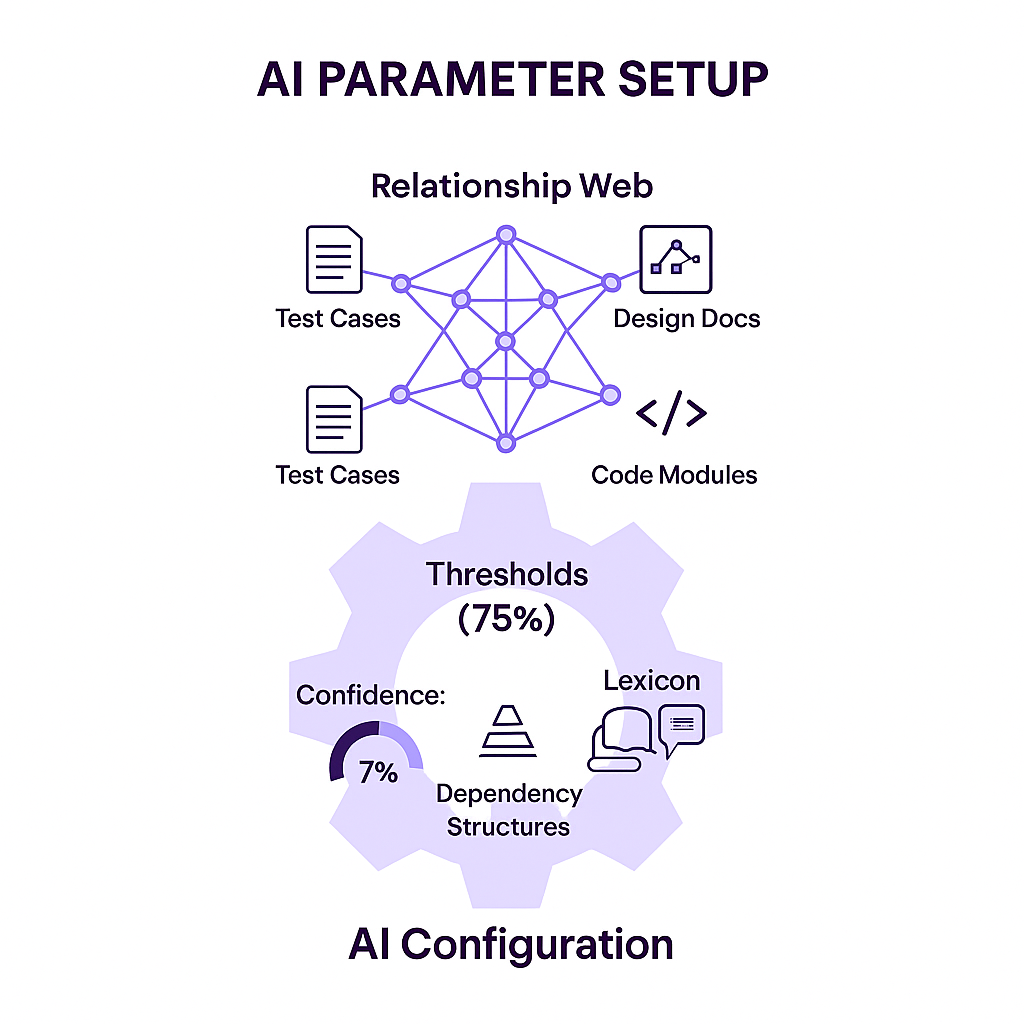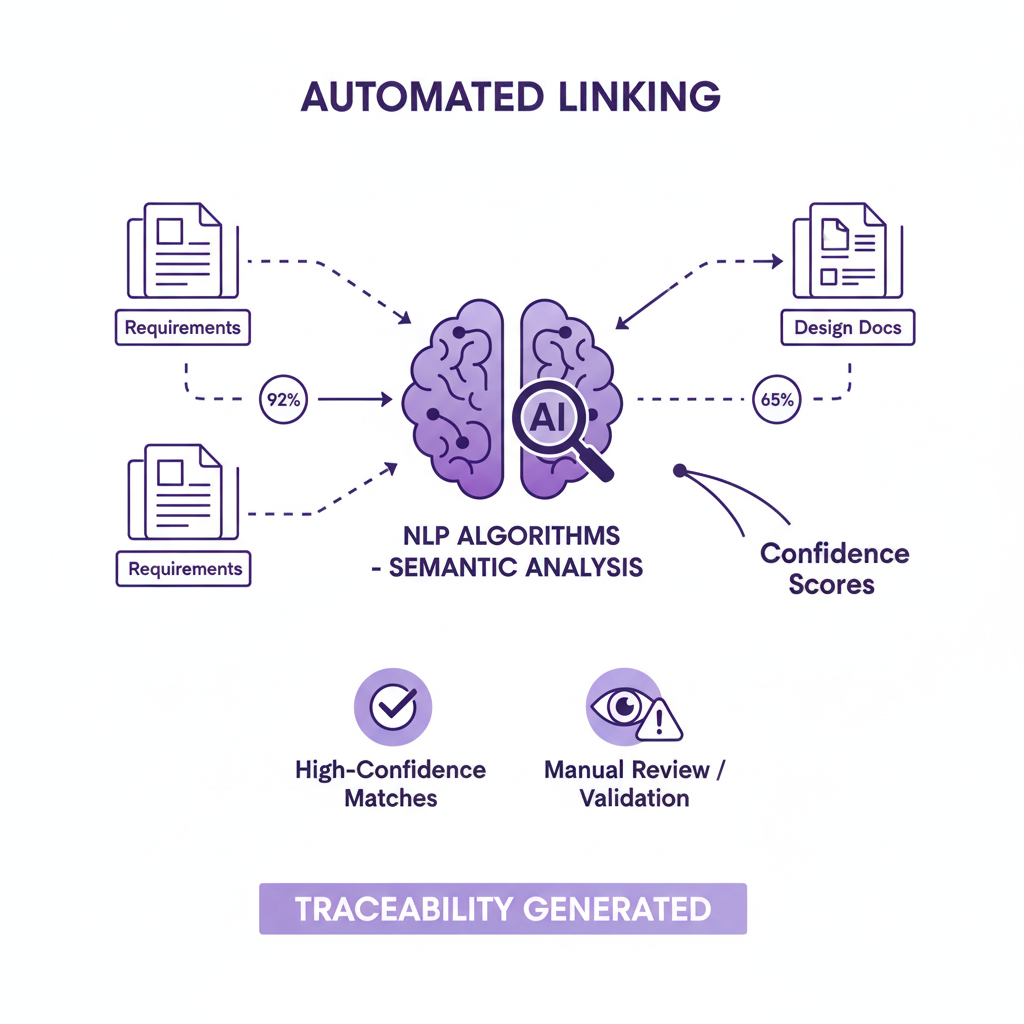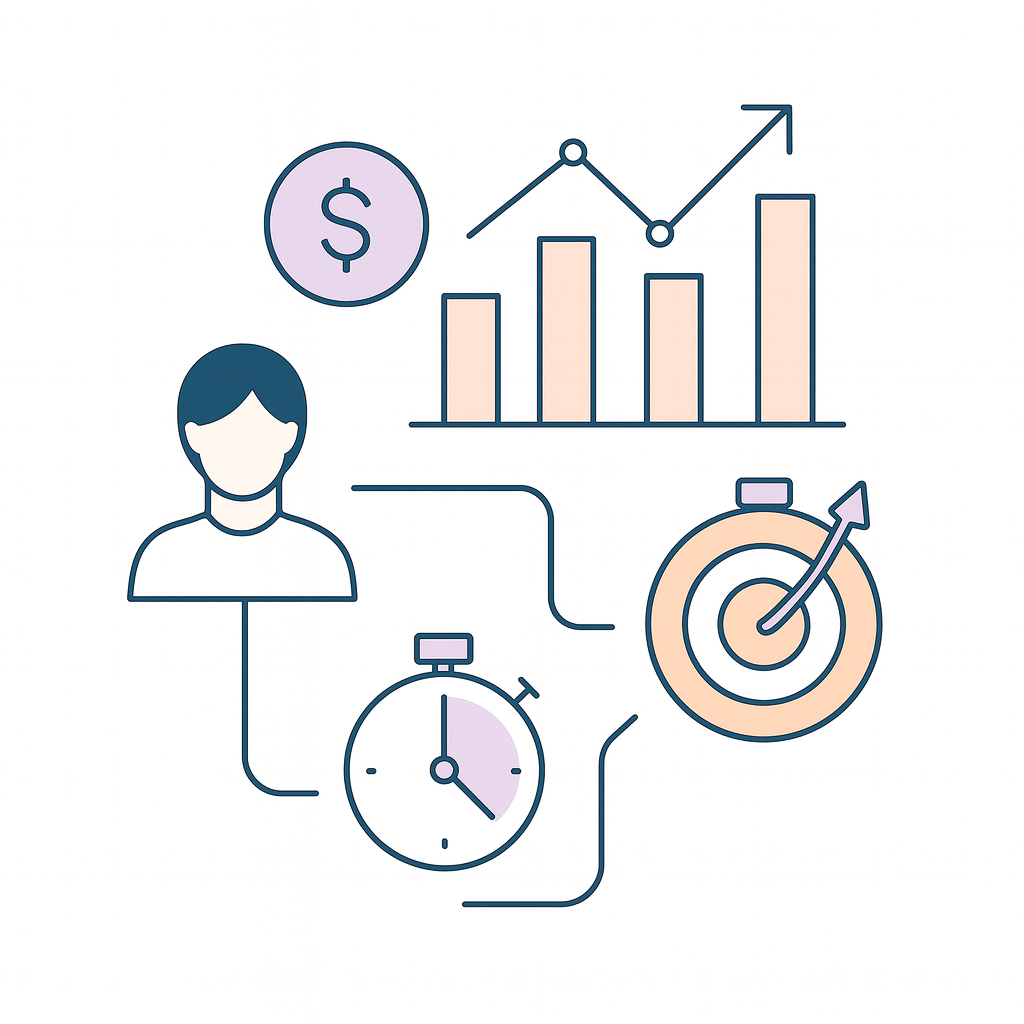Did you know nearly 48% of project failures trace back to poorly managed requirements? That gap costs companies millions in delays, defects, and compliance penalties.
Learning how to create a requirement traceability matrix with AI helps you eliminate those risks, bringing speed, accuracy, and audit-ready confidence to even the most complex projects.
In this article, we will:
- Follow clear steps to build an AI-powered requirement traceability matrix
- Track success with KPIs and calculate ROI for your RTM
- Compare manual and AI methods to see which delivers better results
AI-powered requirement traceability matrix: Step-by-step implementation process
Creating a requirement traceability matrix traditionally takes weeks of manual effort and is prone to human error. With artificial intelligence, you can automate this process, reduce creation time by up to 80%, and maintain accuracy throughout your project lifecycle.
Let's walk through the exact steps to implement an AI-powered RTM system.
Step 1: Prepare your requirements data
Data preparation is the foundation of successful AI implementation. Poor quality input data will result in inaccurate traceability links and unreliable matrix outputs.
- Collect requirements from all project stakeholders, including business analysts, product owners, and technical teams
- Consolidate scattered documentation from emails, meeting notes, spreadsheets, and legacy systems into a single location using a project folder structure template for consistent organization.
- Remove duplicate requirements and resolve conflicting specifications before proceeding
- Assign unique identifiers to each requirement using a consistent naming convention (e.g., REQ-001, UC-001)
Pro tip: Create a requirements checklist template that includes mandatory fields like requirement ID, description, priority level, and source document. This standardization will significantly improve AI processing accuracy.
Step 2: Choose the right AI tools and platforms
Selecting the appropriate AI-powered RTM tool determines your project's success and long-term maintainability. Different tools excel in various areas, so alignment with your specific needs is crucial.
- Evaluate leading platforms like Jama Connect for enterprise-scale projects, ReQtest for agile teams, or Modern Requirements4DevOps for Microsoft environments
- Assess integration capabilities with your existing tools like Jira, Azure DevOps, or Confluence
- Consider scalability requirements based on your project size and organizational growth plans
- Review pricing models, including per-user licensing, feature-based tiers, and implementation costs
Example: A healthcare software company might prioritize FDA compliance features and audit trail capabilities, while a startup might focus on cost-effectiveness and rapid deployment options.
Step 3: Configure AI parameters and rules
Proper configuration ensures the AI system understands your project's unique context and generates relevant traceability relationships. Generic settings rarely produce optimal results.
- Define traceability rules specifying which requirement types should link to test cases, design documents, or code modules
- Establish requirement hierarchies showing parent-child relationships and dependency structures
- Set confidence thresholds for automatic link creation versus manual review requirements
- Customize domain-specific vocabularies and terminology recognition for your industry

Pro tip: Start with conservative confidence thresholds (70-80%) during initial setup. You can gradually increase automation levels as the system learns your project patterns and improves accuracy.
Step 4: Import and process requirements
The import process transforms your prepared data into a format the AI system can analyze and process. Proper handling of different requirement formats ensures comprehensive coverage.
- Upload requirements using supported formats like Excel, CSV, JSON, or direct API integrations
- Map data fields to ensure requirement descriptions, IDs, and metadata align correctly
- Verify parsing accuracy by reviewing a sample of imported requirements for completeness
- Handle format variations, including user stories, use cases, functional specifications, and acceptance criteria
Example: When importing user stories, ensure the AI recognizes the standard "As a [user], I want [goal], so that [benefit]" format and can extract actors, actions, and outcomes for better traceability mapping.
Step 5: Generate initial traceability links
This step leverages natural language processing to identify relationships between requirements and create automated traceability connections. The AI analyzes semantic similarities and contextual relationships.
- Execute automated linking using NLP algorithms that analyze requirement text and identify semantic relationships
- Review confidence scores for each suggested link, focusing on high-confidence matches first
- Examine cross-references between requirements, test cases, and design documents
- Validate suggested relationships by spot-checking a representative sample of AI-generated links

Pro tip: Pay special attention to requirements containing similar keywords but different contexts. The AI might suggest false positive links that need manual correction during the review phase.
Step 6: Review and refine AI-generated matrix
Human oversight ensures accuracy and catches nuances that AI might miss. This validation step is crucial for maintaining matrix reliability and stakeholder confidence.
- Conduct a systematic review of all AI-suggested traceability links, starting with low-confidence scores
- Identify false positives where the AI incorrectly linked unrelated requirements
- Add missed connections that the AI failed to detect, especially complex business rule relationships
- Provide feedback to train the AI system and improve future accuracy
Example: An AI might link "user login functionality" to "password encryption" correctly but miss the connection to "session timeout requirements" if the terminology differs significantly between documents.
Step 7: Implement continuous monitoring
Ongoing monitoring ensures your RTM remains accurate as requirements evolve throughout the project lifecycle. Automation reduces maintenance overhead and keeps stakeholders informed.
- Enable real-time synchronization so requirement changes automatically update traceability links
- Configure impact analysis to identify downstream effects when requirements are modified or removed
- Set up automated alerts for broken links, missing traceability, or coverage gaps
- Schedule regular reviews to validate AI performance and adjust parameters as needed
Pro tip: Create a dashboard showing RTM health metrics like coverage percentage, broken links, and recent changes. This visibility helps project managers identify issues before they impact deliverables and maintains stakeholder confidence in the system.
Following these seven steps systematically ensures your AI-powered RTM delivers accurate traceability while reducing manual effort significantly.
Measuring RTM success: Proven KPIs and ROI calculation methods
Implementing an AI-powered RTM without measuring its impact is like driving blindfolded. Clear metrics help you justify the investment, optimize performance, and demonstrate value to stakeholders throughout the project lifecycle.

Key performance indicators to track
Effective measurement starts with selecting the right KPIs that reflect both operational efficiency and business value. Focus on metrics that directly correlate with your project goals and organizational priorities.
Primary efficiency metrics:
- Time reduction: Measure hours saved in RTM creation, updates, and maintenance activities
- Coverage percentage: Track the ratio of traced requirements to total requirements in your project
- Link accuracy rate: Monitor the percentage of correct traceability relationships versus false positives
- Change impact speed: Calculate how quickly you can assess requirement modifications across the entire system
Quality and compliance indicators:
- Defect detection rate: Count issues identified through improved traceability before reaching production
- Audit compliance score: Measure adherence to regulatory requirements and internal quality standards, capturing evidence with a project audit template for smoother reviews
- Missing requirement alerts: Track gaps in traceability coverage that could pose project risks
Before vs. after metrics comparison
Establishing baseline measurements before AI implementation creates a compelling narrative for stakeholders and helps identify specific improvement areas that drive the most value.
Traditional RTM baseline:
- Manual matrix creation: 40-60 hours for medium projects (500-1000 requirements)
- Update frequency: Weekly or bi-weekly due to manual effort constraints
- Error rate: 15-25% incorrect or missing traceability links
- Coverage gaps: 10-20% of requirements lack proper traceability
AI-powered RTM performance:
- Automated creation: 4-8 hours for a similar project scope
- Real-time updates: Continuous synchronization with requirement changes
- Enhanced accuracy: 85-95% correct linkages with minimal human validation
- Complete coverage: Near 100% traceability with automated gap detection
Cost-benefit analysis framework
A structured approach to ROI calculation helps you quantify investment returns and make data-driven decisions about tool selection and implementation scope.
Implementation costs to consider:
- Software licensing fees (typically $50-200 per user monthly)
- Initial setup and configuration time (20-40 hours for standard implementations)
- Training investment: Team onboarding and skill development activities
- Integration expenses for connecting with existing project management tools
Quantifiable benefits calculation:
- Labor cost savings: Multiply the time reduction by the hourly rates of the team members involved
- Risk mitigation value: Estimate costs avoided through early defect detection and improved compliance
- Productivity gains: Factor in faster decision-making and reduced project delays
- Quality improvement benefits: Calculate the value of enhanced customer satisfaction and reduced rework
ROI formula: (Total Benefits - Implementation Costs) ÷ Implementation Costs × 100
Long-term value measurement
Sustainable success requires ongoing assessment that extends beyond initial implementation metrics. Long-term measurement reveals compound benefits and optimization opportunities.
Quarterly review indicators:
- Team productivity trends: Track individual and collective efficiency improvements over time
- Process optimization opportunities: Identify workflow enhancements and automation possibilities
- Stakeholder satisfaction scores: Measure user experience and adoption levels across different teams
- Knowledge retention metrics: Assess how well institutional knowledge is captured and maintained
Annual strategic assessment:
- Competitive advantage gains: Evaluate faster time-to-market and improved product quality
- Scalability benefits: Measure your ability to handle larger projects without proportional resource increases
- Innovation enablement: Track how improved traceability supports new product development and experimentation
Regular measurement ensures your AI-powered RTM continues delivering maximum value while identifying areas for continuous improvement and expansion.
Manual vs AI RTM: Which approach drives better project outcomes?
Choosing between manual spreadsheet management and AI-powered automation isn't just about technology; it's about project success and team productivity. This comparison reveals the true cost of manual processes and quantifies the benefits of intelligent automation.
Why manual RTM methods fail at scale
Organizations using spreadsheet-based RTM systems report 40-60% more time spent on requirements management with significantly lower accuracy rates. What starts as a simple tracking solution quickly becomes a project bottleneck.
Critical limitations of manual approaches:
- Version control conflicts when multiple team members edit simultaneously
- Human error accumulation through manual data entry and updates
- Delayed change detection leading to costly late-stage corrections
- Limited scalability beyond 500 requirements or 10 team members
The transition to AI-powered RTM typically pays for itself within the first project through reduced rework, faster delivery cycles, and improved compliance outcomes.
Turn scattered requirements into a single source of truth
Relying on manual tracking often leads to missed details, duplicated work, and costly compliance gaps. With AI-driven traceability, every requirement, test, and change connects seamlessly in one centralized view. The payoff is faster delivery, fewer errors, and stronger audit readiness.
By transforming fragmented processes into a single source of truth, teams gain the clarity and control needed to manage complexity and deliver projects with confidence.


%20(1).jpg)
_light%201.png)





